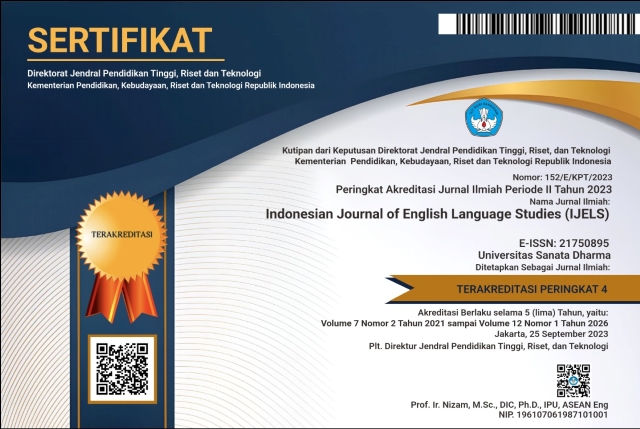Cultural Identity and Intertextual Discourse: A Study of Paper Menagerie by Ken Liu
(1) Karabuk University, Turkey
(*) Corresponding Author
Abstract
This study investigates the intricate interplay between intertextuality and discourse in Ken Liu’s evocative short story Paper Menagerie, focusing on cultural identity negotiation and heritage language dynamics. Through qualitative literary analysis involving multiple close readings, thematic coding, comparative contextualization, and detailed interpretation, the interplay between Liu’s masterful integration of multifaceted cultural allusions and the discourse patterns surrounding generational language divides and struggles with self-concept is examined. The analysis reveals how Liu adeptly employs intertextuality through origins, Qingming festivities, and other symbols to create resonance and authenticity in exploring assimilationist tensions, while patterns in the text reinforce acculturative pressures and resulting linguistic barriers faced by immigrants. Ultimately, these layers synergize to reflect deeply on the preservation of identity tensions. As with textual analysis, subjective interpretive constraints persist, limiting generalizability. Further exploration through intertextual threads in Liu’s broader writings could enrich the understanding of his versatile identity while revealing philosophical evolution. The intricate symbiosis between intertextuality and discourse breathes life into this narrative, crystallizing universally relatable experiences through a culturally specific lens. While bittersweet, Liu’s artistry is a poignant reminder that interweaving past and present fosters empathy across paper menageries.
Keywords
Full Text:
PDFReferences
Alhusami, M. A. A. H. (2021). Tradition versus modernity in Laila al-Juhani’s The Waste Paradise: An Intertextual Approach. Theory and Practice in Language Studies, 11(10), 1197-1202. http://dx.doi.org/10.17507/tpls.1110.07
Allen, G. (2011). Intertextuality (2nd ed.). London: Routledge. https://doi.org/10.4324/9780203829455
Anderson, B. (2020). Imagined communities: Reflections on the origin and spread of nationalism. Routledge.
Austermühl, F. (2014). The great American scaffold: Intertextuality and identity in American presidential discourse. Amsterdam: Johns Benjamin Publishing.
Blommaert, J. (2005). Discourse: A critical introduction. Cambridge: Cambridge University Press.
Bula, A. (2022). Citation and narration as the Nexus of Kristeva’s theory of intertextuality. Journal of Critical Studies in Language and Literature, 3(2), 7-14. http://dx.doi.org/10.46809/jcsll.v3i2.130
Charmaz, K., & Belgrave, L. L. (2019). Thinking about data with grounded theory. Qualitative Inquiry, 25(2), 743-753. http://dx.doi.org/10.1177/1077800418809455
Clarke, V., & Braun, V. (2017). Thematic analysis. The journal of positive psychology, 12(3), 297-298. https://doi.org/10.1080/17439760.2016.1262613
Corbin, J., & Strauss, A. (2015). Basics of qualitative research: Techniques and procedures for developing grounded theory (4th ed.). Thousand Oaks, CA: SAGE Publications, Inc.
Guion, L. A. (2001). Triangulation: Establishing the validity of qualitative studies. University of Florida Cooperative Extension Service, Institute of Food and Agricultural Sciences, EDIS.
Huddart, D. (2006). Homi K. Bhabha (1st ed.). London: Routledge.
Jørgensen, M. W., & Phillips, L. J. (2002). Discourse analysis as theory and method. London: SAGE Publications Ltd.
Li, L., & Guo, J. (2021). Pragmatic functions of intertextual rhetorical devices in political discourse. International Journal of Education and Social Science Research, 4(01), 150-162. http://dx.doi.org/10.37500/IJESSR.2021.4116
Li, T. (2022). Intertextuality between French literature creation and literature translation based on feature extraction and Gram Matrix. Wireless Communications and Mobile Computing, 2022.
Linnichenko, S. I. (2021). Intertextuality as a modern linguo-cognitive practice: New forms of linguistic expression in the German postmodern literature. Вестник Самарского университета. История, педагогика, филология, 27(2), 103-111.
Mills, S. (2004). Discourse. London: Routledge.
Radulović, M. R. (2021). Intertextuality of the Waste Land by TS Eliot. Reči, Journal of Language, Literature and Culture, 12(14), 126-147.
Stein-Smith, K. (2023). French as a US heritage language in a multilingual world. Theory and Practice in Language Studies, 13(3), 535-543. http://dx.doi.org/10.17507/tpls.1303.01
Tvaltvadze, D., & Gvelesiani, I. (2020, May). The educational policies for safeguarding and transmitting the language as an intangible cultural heritage. Society. Integration. Education. Proceedings of the International Scientific Conference, 5, 570-578.
Yoshioka-Maxwell, L. (2017). “Un créole extrêmement vivace”: Linguistic Identity and Belonging in Bessora’s 53 cm. Critical Multilingualism Studies, 5(2), 149-177.
DOI: https://doi.org/10.24071/ijels.v10i1.7615
Refbacks
- There are currently no refbacks.

This work is licensed under a Creative Commons Attribution-ShareAlike 4.0 International License.
IJELS Journal Sinta 4 Certificate (S4 = Level 4)
We would like to inform you that Indonesian Journal of English Language Studies (IJELS) has been nationally accredited Sinta 4 by the Ministry of Education, Culture, Research and Technology of the Republic of Indonesia based on the decree No. Surat Keputusan 152/E/KPT/2023. Validity for 5 years: Vol 7 No 2, 2021 till Vol 12 No 1, 2026

This work is licensed under CC BY-SA.
Creative Commons Attribution-ShareAlike 4.0 International License
IJELS e-ISSN 2715-0895; IJELS p-ISSN 2442-790X
Indonesian Journal of English Language Studies (IJELS) is published twice a year, namely in March and September, by the English Language Studies (ELS) of the Graduate Program of Sanata Dharma University, Yogyakarta, Indonesia.


 IJELS p-ISSN:
IJELS p-ISSN: 










